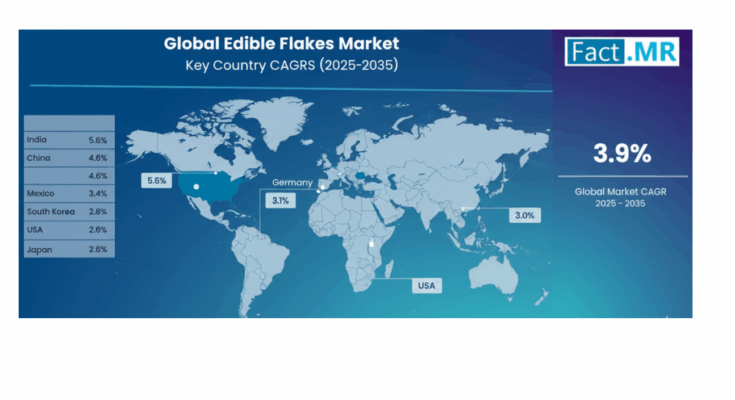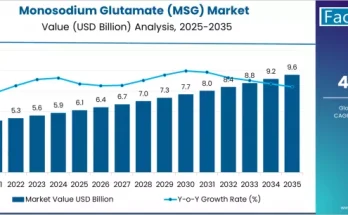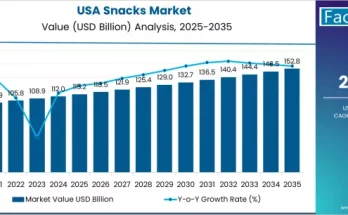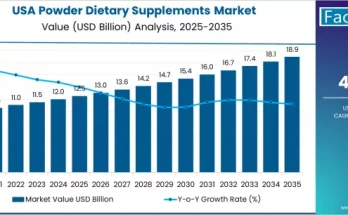The global edible flakes market is projected to grow from USD 12.8 billion in 2025 to USD 18.7 billion by 2035, reflecting a 46.1% increase and a compound annual growth rate (CAGR) of 3.9% over the forecast period. The edible flakes market growth is being driven by rising consumer demand for convenient, nutritious breakfast solutions, growing awareness of healthy eating, and technological advancements in food processing and packaging.
According to the latest market analysis, the edible flakes industry is expected to expand by nearly 1.5 times by 2035. This acceleration is largely supported by a global lifestyle shift toward fast, ready-to-eat, and health-oriented food options. The increasing preference for fortified cereals and whole-grain breakfast products has positioned edible flakes as a staple in modern dietary patterns, fueling consistent market expansion across developed and emerging economies.
Between 2025 and 2030, the edible flakes market is forecast to rise from USD 12.8 billion to USD 15.4 billion, adding USD 2.6 billion in value and contributing approximately 44% of the decade’s total growth. This phase will be defined by strong consumer adoption of convenient breakfast formats, increased product innovation, and the integration of edible flakes into diverse food service applications. From 2030 to 2035, the market is expected to grow by another USD 3.3 billion, reflecting technological advances in production efficiency, automation, and nutritional fortification.
The global edible flakes market growth is primarily driven by evolving consumer preferences for nutritious, time-saving foods. As urbanization increases and busy lifestyles become the norm, breakfast cereals and edible flakes offer consumers a balance of convenience, taste, and essential nutrients. Manufacturers are investing in automated manufacturing systems and digital quality control technologies to enhance efficiency, product consistency, and traceability across supply chains. This modernization is improving product quality while ensuring that edible flakes meet increasingly stringent health and safety standards.
By product type, corn flakes continue to dominate the edible flakes market with a 45% share in 2025. Their widespread popularity stems from affordability, appealing flavor, and nutritional benefits. Manufacturers are further strengthening this segment through fortified and multigrain variants enriched with vitamins, minerals, and fiber. Meanwhile, oat flakes and wheat/rice flakes are witnessing increased demand from consumers seeking whole-grain, high-fiber, or gluten-free breakfast options. The ongoing introduction of flavored, organic, and sustainably packaged products is expanding consumer engagement across global markets.
In terms of distribution channels, retail sales account for nearly 70% of edible flakes market revenue. The segment’s dominance is driven by the expansion of organized retail networks, supermarkets, and e-commerce platforms that provide accessibility, variety, and attractive promotional opportunities. Modern consumers increasingly prefer purchasing edible flakes through convenient retail channels offering trusted brands and innovative packaging. The foodservice sector is also showing promising growth as edible flakes find new applications in hospitality, institutional catering, and snack formulations.
By nature, conventional edible flakes represent approximately 90% of total sales in 2025, supported by cost-effective production systems and consistent quality standards. However, organic edible flakes are gaining momentum, especially among health-conscious consumers and premium retail outlets emphasizing clean-label and sustainable food options. This shift reflects a growing global appetite for transparency, authenticity, and environmentally responsible sourcing in food production.
Regionally, the Asia Pacific edible flakes market is forecast to record the highest growth rate through 2035, led by India and China. India’s market is expected to grow at a robust 5.6% CAGR, supported by rising consumer awareness, expanding urban populations, and government initiatives promoting food processing modernization. China follows closely with a 4.6% CAGR, benefiting from the growing popularity of Western-style breakfasts, expanding domestic cereal manufacturing, and strategic partnerships between global and local brands. Together, India and China will account for a substantial share of future edible flakes consumption.
In North America, the United States edible flakes market maintains its technological leadership, growing at a 3.0% CAGR through 2035. The region’s mature food industry and focus on fortified, low-sugar, and whole-grain products support sustained growth. In Europe, the market is forecast to expand from USD 6.4 billion in 2025 to USD 9.4 billion by 2035, registering a CAGR of 3.9%. Germany, the United Kingdom, and France remain key contributors due to their advanced food manufacturing capabilities and health-conscious consumer bases. Latin America, particularly Mexico, is also showing strong potential, with a 3.4% CAGR supported by modern retail expansion and rising breakfast awareness. Meanwhile, Japan and South Korea are emphasizing innovation, precision, and technology integration in breakfast solutions, setting new standards for the premium edible flakes market.
The competitive landscape of the edible flakes industry is defined by the presence of leading international brands and specialized regional producers. Key players include Kellanova (Kellogg’s), General Mills, Nestlé, PepsiCo (Quaker), Post Holdings, Marico (Saffola), Weetabix, and Bagrry’s. These companies are investing heavily in innovation, fortified formulations, automation, and sustainable sourcing practices to strengthen their positions in the global market. Many are also focusing on product customization and digital marketing to enhance consumer engagement and brand loyalty.
Industry leaders such as Kellanova (Kellogg’s) and Nestlé are emphasizing premium, health-focused product lines and advanced processing technologies to maintain quality consistency and nutritional value. Regional players like Marico and Bagrry’s are expanding aggressively in high-growth Asian markets by offering affordable, nutritious, and locally relevant cereal solutions. The increasing collaboration between global brands and local distributors is further improving supply chain efficiency and product reach.
In conclusion, the edible flakes market forecast from 2025 to 2035 indicates a strong and sustainable growth trajectory supported by health trends, convenience demand, and continuous technological progress. As consumers prioritize balanced nutrition and easy-to-prepare meals, edible flakes will remain a cornerstone of modern breakfast culture worldwide. The industry’s future lies in innovation, sustainability, and regional market expansion, ensuring that edible flakes continue to meet evolving global dietary preferences and quality expectations.
Browse Full Report : https://www.factmr.com/report/edible-flakes-market



